Running a company means wearing a lot of hats, and let’s be honest: your sales team really doesn’t need another time-consuming task. Lead generation is crucial for attracting new customers, but it often eats up a significant portion of your sales and marketing teams’ time.
So, how can you automate something that, on the surface, seems to require a fair amount of human touch — without losing the quality of your generation efforts?
The answer lies in automating repetitive tasks with software platforms. Automated lead generation fills your pipeline with high-quality leads without manual effort, so your sales and marketing team can focus on what they do best — closing deals.
What is automated lead generation?
When you think about automation, do images of giant factories churning out cars made by robots come to mind? Well, car factories and automated lead generation have more in common than you think.
Both let technology do the heavy lifting on repetitive, everyday tasks, leaving you free to concentrate on those irreplaceably human jobs, like directly interacting with customers.
With lead generation automation tools, you can instantly collect email addresses from prospective customers and enter them into your sales funnel and beyond, all without lifting a finger.
These tools don’t just stop at collecting info, they help convert your prospects into qualified leads, too. All of this means you’ll reduce your marketing efforts and zero in on those potential leads that are more worthy of your time.
The 7 best lead automation tools for your business
Automation and AI are big buzzwords right now, so finding marketing automation platforms that aren’t just the original software with a generative AI bolted on can be difficult.
Luckily, we’ve done the research for you and found the 7 best and most functional automation tools to help your business. Let’s check them out.
1. Method
Method CRM is the #1 CRM and lead management tool for QuickBooks and Xero users. Capture and nurture leads with ease, and when they convert to sales, your accounting software updates automatically — no extra steps needed. It helps businesses nurture and capture leads all the way from first contact to final payment.
Pros
- Unbeatable integration with QuickBooks and Xero.
- Easy digital smart forms.
- Online 24/7 self-service customer portals with integrated payment processing.
- Sales and marketing automation tools like invoicing and follow-ups.
- Robust third-party integrations with Zapier, Outlook, Google Workspace, and more.
- Customizable to your workflows, with one hour of free customization consultation included.
Cons
- Most suitable for businesses that use QuickBooks or Xero.
- Only available in English.
Pricing
Method offers three pricing plans, billed annually or monthly:
- Contact Management: $25 per user/month.
- CRM Pro: $44 per user/month.
- CRM Enterprise: $74 per user/month.
There is also a 14-day free trial available with no credit card required.
2. OptinMonster
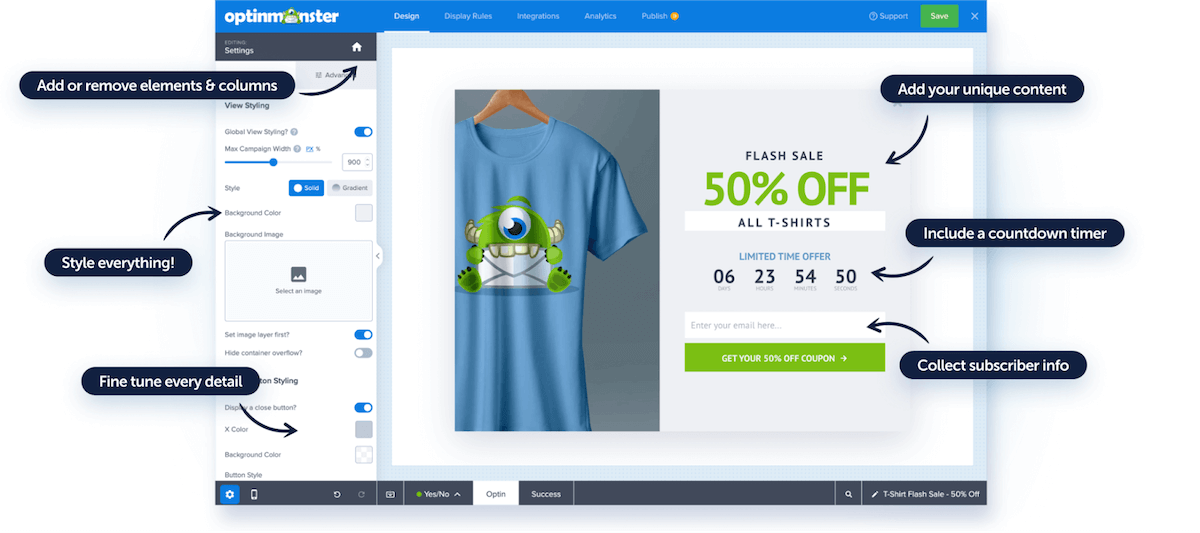
Image credit: OptInMonster
OptinMonster is a specialized platform that helps convert website visitors into high-quality leads with engaging pop-up messages and smart forms that capture contact details and boost conversions.
Pros
- Very user-friendly design for creating opt-in forms.
- Easy form creation with a drag-and-drop builder.
- White label branding for your business.
- Advanced targeting and triggers.
- A/B testing and analytics to optimize campaigns.
Cons
- Manual URL segmentation can be a hassle.
- Limited customization of pop-ups and forms.
- Pricing might stretch small business budgets.
- Support response times can be slow.
Pricing
OptinMonster offers four pricing plans, billed monthly:
- Basic: $21 per month for one site and up to 2,500 pageviews.
- Plus: $57 per month for up to two sites and 10,000 pageviews.
- Pro: $87 per month for up to three sites and 25,000 pageviews.
- Growth: $147 per month for up to five sites and 100,000 pageviews.
There is no free trial available, but OptinMonster offers a 14-day money-back guarantee.
3. Leadfeeder
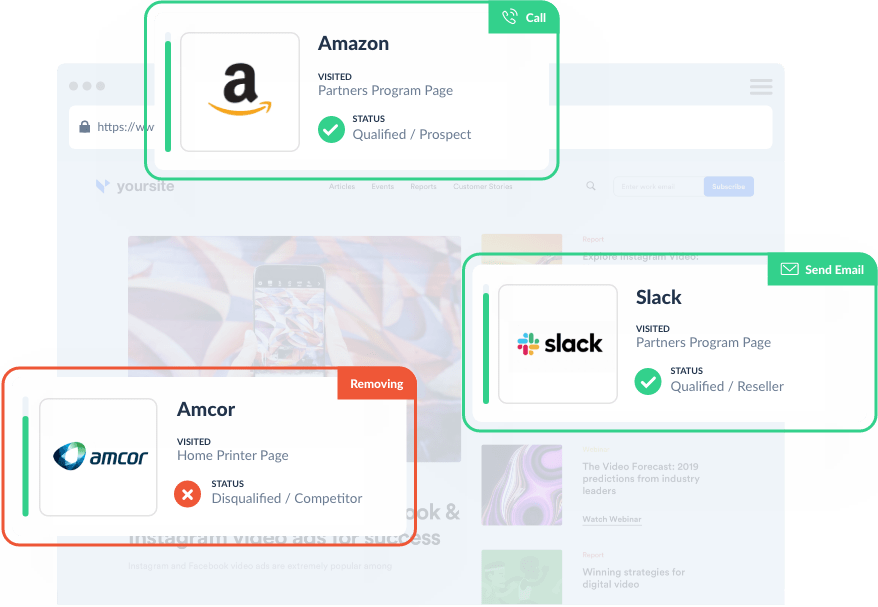
Image credit: Leadfeeder
The next top lead automation tool is Leadfeeder. It helps marketing teams keep better track of website visitors and uncovers B2B prospects who are showing interest in your business.
Pros
- Real-time insights into interested companies.
- Smart lead prioritization with automatic scoring.
- Tailored feeds to spotlight top prospects.
- Comprehensive, high-volume tracking across channels.
Cons
- High cost for smaller businesses.
- Integration capability needs improvement with more popular tools.
- Functionality is based on tracking cookies and IP addresses, limiting the ability to retarget.
- Reports of unexpected subscription auto-renewals and unreliable support.
Pricing
Leadfeeder offers two pricing plans:
- Free: Includes last 7 days of data only and up to 100 identified companies.
- Paid: Starts at $165 per month and increases based on your amount of identified companies.
They also offer a 14-day free trial and a 40% discount on annual subscriptions.
4. Sprout Social
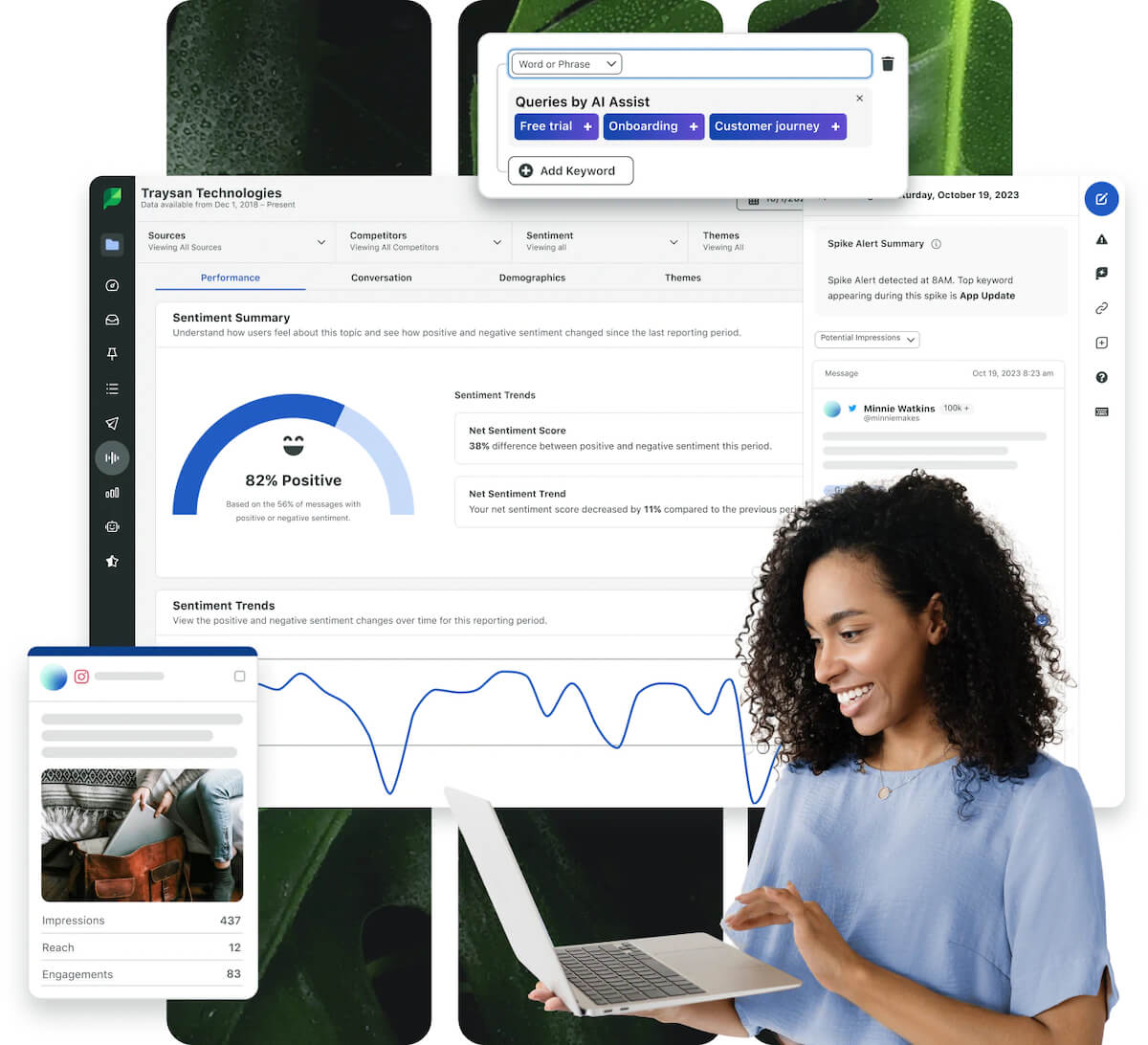
Image credit: Sprout Social
As one of the best social media marketing automation and enrichment tools available, Sprout Social simplifies content management across multiple platforms for marketing teams of various sizes.
Pros
- Stronger insights into what’s popular with top-notch social listening tools.
- Detailed reporting and analytics.
- Easy team collaboration with user-friendly workflows.
- Powerful scheduling features for optimal post timing.
- Solid customer support.
Cons
- Limited to 5 social media accounts on the standard plan.
- Expensive add-ons required for advanced features.
- Steep learning curve for new users.
- Limited functionality for LinkedIn tagging and Instagram Reels scheduling.
- Smaller businesses might be priced out of even simple plans.
Pricing
Sprout Social has four pricing plans available:
- Standard: $249 per seat per month.
- Professional: $399 per seat per month.
- Advanced: $499 per seat per month.
- Enterprise: Pricing available on request.
They also offer a 30-day free trial and a discount on annual subscriptions of up to 25%.
5. Mailchimp
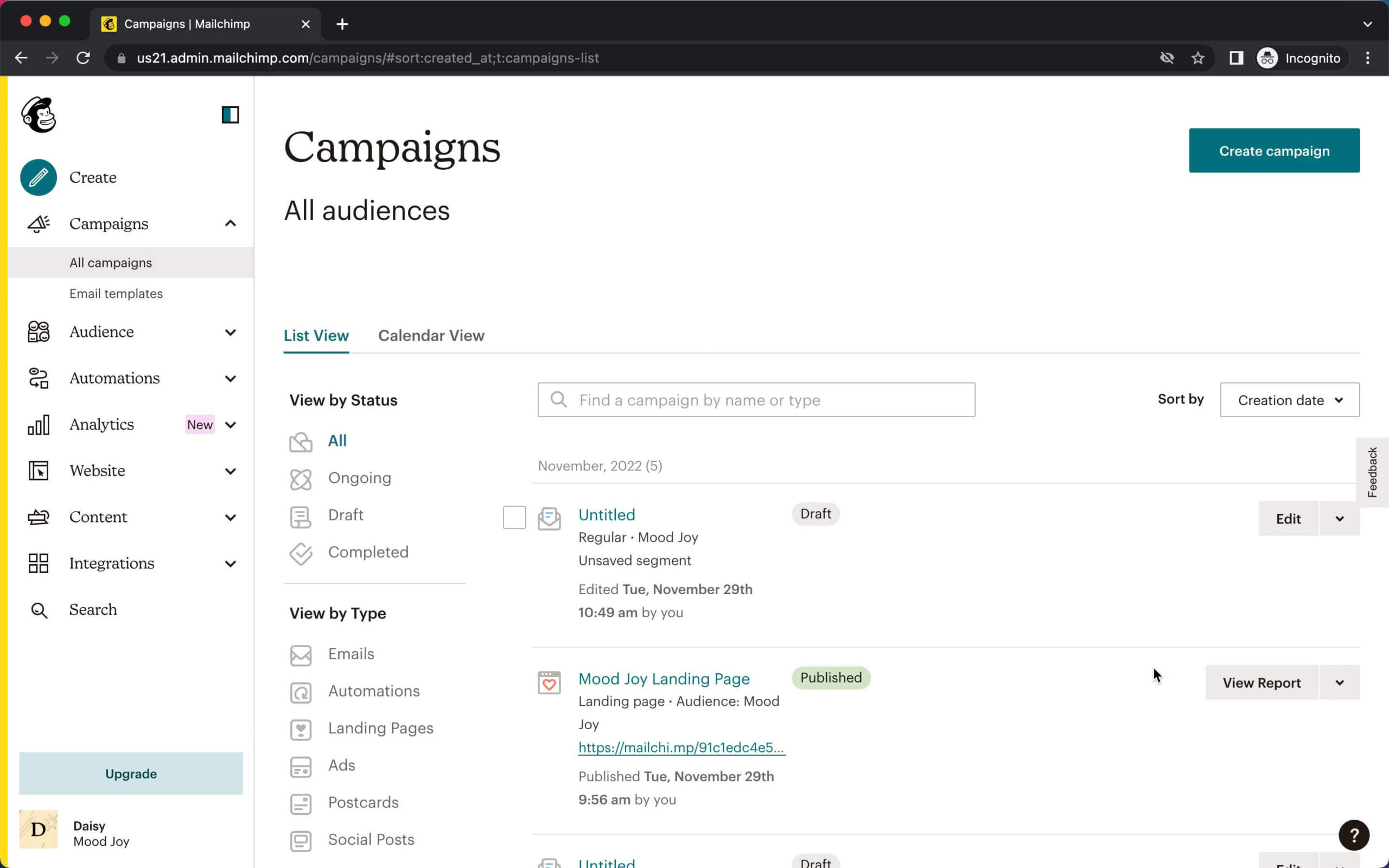
Image credit: Page Flows
Owned by Intuit, Mailchimp is best for sending automated marketing campaigns to email addresses. It can also provide detailed analysis and provide insights on how campaigns are progressing.
Pros
- Very easy to use, set up, and integrate.
- Automated data cleaning to keep your lead lists tidy.
- Robust analytics for data-driven insights.
- Solid integrations with other tools.
- Wide range of customizable templates.
Cons
- Lack of customization for emails, as it’s template-based.
- Emails from Mailchimp servers can be classified as spam.
- Pricing gets steep for larger lists.
- Deliverability rates are sometimes inconsistent.
- Customer support varies by plan and can be slow.
Pricing
Mailchimp’s pricing is based on the amount of contacts you need. It offers four base plans, which increase in cost as you add more contacts:
- Free: Includes up to 500 contacts, with 1,000 sends per month.
- Essentials: Starts at $13 per month for 500 contacts, with 5,000 sends per month.
- Standard: Starts at $20 per month for 500 contacts, with 6,000 sends per month.
- Premium: Starts at $350 per month for 10,000 contacrs, with 150,000 sends per month.
Mailchimp’s Essentials and Standard plans also offer a free month-long trial before you commit.
6. Brevo (Formerly SendInBlue)
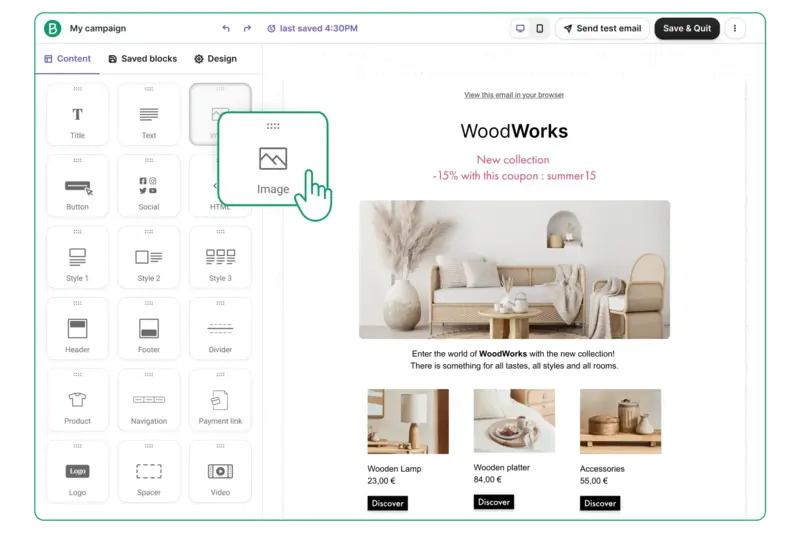
Image credit: Brevo
Brevo, formerly known as Sendinblue, is a versatile tool for B2B and B2C marketing through automated email and SMS campaigns. It’s a powerful tool for converting prospective business customers into high-quality leads.
Pros
- Integrates well with Shopify.
- Easy to track campaign success anytime.
- User-friendly interface that makes navigation easy.
- Robust automation features to enhance marketing efforts.
- Extensive multi-channel campaign options.
Cons
- No design services available.
- Reports can be lacking in detail, especially for less expensive plans.
- Customer support can be slow and lacks live chat functionality.
- Certain features can incur additional costs, such as SMS and WhatsApp campaigns.
Pricing
Brevo offers four pricing plans:
- Free: Send 300 emails a day.
- Starter: Starts at $9 per month, with 5,000 emails a month.
- Business: Starts at $18 per month, with 5,000 emails a month and additional features.
- Enterprise: Custom pricing available on request.
They also offer a 10% discount on annual subscriptions.
7. Marketo
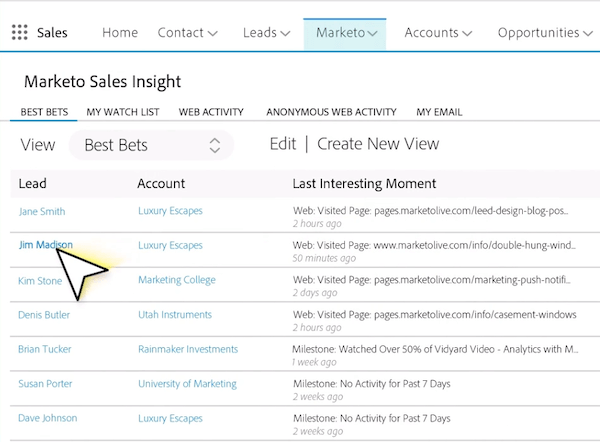
Image credit: Adobe
Marketo Engage, now owned by Adobe, is a powerful marketing automation tool aimed at larger companies and enterprises. It excels in automated data analysis and lead scoring.
Pros
- Easy setup despite its rich feature set.
- Strong integrations with with SAP, Oracle, Salesforce, and NetSuite.
- Lead scoring functionality to enhance targeting.
- Comprehensive analytics for data-driven decisions.
- Powerful marketing automation tools.
Cons
- No built-in CRM limits direct customer management.
- The landing page builder lacks advanced features.
- High cost can be prohibitive for smaller businesses.
- Customer support varies by plan and can be slow.
Pricing
Marketo Engage offers four pricing tiers based on required features and business volume. Specific custom pricing for each of these plans is available on request.
- Growth: Up to 10 users.
- Select: Up to 25 users.
- Prime: Up to 25 users.
- Ultimate: Up to 25 users.
While user limits stay mostly consistent as you upgrade your plan, you get access to more features and tools.
Examples of lead automation
Automation isn’t just a one-size-fits-all approach to lead generation — it’s got options. It all depends on exactly what efforts you’re willing to assign to the software, and what tasks will remain human.
Let’s take a look at some of those options.
Automated cold outreach
While some salespeople do legitimately love it, most people find cold calling to be soul-crushing. With automated email marketing campaigns, you can send hyper-personalized messages at scale, all while still making it feel like a human-on-human chat.
Automation makes it all possible by using generation automation tools that tailor your outreach based on the ideal customer profile you have given it.
AI chatbots
Are you tired of answering the same old questions over and over? Enter AI chatbot pop-ups.
These bots engage with the users on your site, automatically capturing their contact details. You can set them up to learn from and address those common questions and concerns that come in on a regular basis.
Best of all, they can take on the role of salesperson and start turning curious visitors into prospective customers or even qualified leads.
Lead magnets with smart digital forms
Lead magnets are irresistible little freebies that offer up some valuable content hiding behind a smart digital form. Some examples include:
- Ebooks.
- Checklists.
- Templates.
- Webinars.
- Quizzes.
- Podcasts.
Lead magnets are powerful tools because once a prospective customer bites, you can automatically add them to a drip campaign that nurtures them into high-quality leads.
Personalized website experiences
Nothing in the world says “we understand you” like a website that’s completely personalized. A good example of automated lead generation is through dynamic landing pages that are customized to each potential customer’s needs or industry.
Using automation to personalize experiences means your website itself is boosting engagement and moving them further down the sales funnel without you ever having to be there.
Automated ad campaigns
Ever had site visitors that just slipped through the cracks after a lengthy look around your site? Automated ad campaigns bring visitors back into your funnel with retargeted campaigns that follow them around.
The result? Without any human involvement from the sales team, automation is giving them a second chance to say yes.
Lead tracking with a CRM
Forget about tracking every single lead manually. Let automated CRMs like Method handle it for you.
CRMs organize your leads for more efficient generation efforts and keep your sales funnel clean by separating potential sales from paying customers.
So, you can keep your customers’ financial data safe and accurate in QuickBooks, for example, while also using that information in your CRM data to nurture leads better and inform future sales.
Automatic lead scoring and segmentation
Marketing and sales teams know that not all leads are created equal. And if you’re tired of manually scoring and segmenting hot and cold leads, you’ll be glad to know automation has got this covered too.
These features automatically rank your leads based on their likelihood to convert, helping your team prioritize the high-quality leads first.
Lead prospecting on social media
You shouldn’t only limit your generation efforts to emails and paid ads. According to our research, 62.5% of the world now uses social media. Platforms like LinkedIn, Facebook, X (Twitter), YouTube, and Instagram are filled to the brim with prospective customers.
With so many platforms to cover, manually marketing every single one would be nearly impossible for smaller marketing teams. But with automation and the right generation tools, the leads from social media will keep rolling in.
Benefits of automated lead generation
Most sales teams have felt the burn of frustration when one too many human errors let potential clients slip through the cracks and straight into the arms of competitors.
Let’s take a look at the rest of the benefits.
Send every lead to the correct sales rep
Ever sent an individual customer to the dedicated B2B rep? Or a top-priority lead to the brand-new hire? Mistakes like these are not only signs of disorganization, but you can easily lose a prospective customer because of them.
With automated lead tracking and enrichment tools, leads won’t end up getting sent to the wrong sales rep ever again. This is because advanced algorithms and segmentation can route potential clients straight to the right team member, boosting the team’s productivity.
Personalize your lead experience
Your business isn’t generic, so why should your customers settle for boilerplate messages? With automation, you can segment your leads by important verticals like industry, demographic, or specific interests.
In a nutshell, automation dives deep into your ideal customer profile and sends personalized messages to the right prospective customers at exactly the right time.
Get a complete view of your leads
Want to know what makes your leads tick? Automated lead generation tools give you the complete lowdown on lead behaviour, including what is driving their decisions and what trends they’re following.
This lets you spot trends far faster than the human eye and fine-tune your approach to push leads further down the sales funnel much easier.
Break down data silos
A marketing and sales team that works together is necessary in getting leads to close, so why aren’t your teams talking to each other?
Automation connects your departments and makes sure your sales and marketing teams are always on the same page. More collaboration, far less chaos.
Improve your speed to lead
When it comes to potential customers, there’s a need for speed. Automated lead generation helps you handle those prospective customers faster, so you can respond while they’re still interested — and not when they’ve already forgotten your name.
Ensure consistent lead quality
Tired of wasting time sifting through junk leads? Automated lead generation keeps high-quality leads flowing steadily into your pipeline.
Low-value leads are given less priority, cutting out the guesswork and saving your sales team a lot of time.
Grow and scale without a hitch
Scared of growing your business because of all the extra work and evolving needs? Scaling your business shouldn’t mean more work for your team.
The processes that may have once worked when you were a smaller business are now not working anymore — but that’s a good sign, so don’t panic. Automation means you can grow your business without adding extra workload.
Save time for your entire team by eliminating their repetitive, manual processes like creating invoices and sending emails. They’ll be able to contribute more to your business growth that way.
Generate data-driven insights
With automation, your team grows smarter with every new lead — regardless of whether they convert. Tracking every single interaction with potential customers means ensuring more insights to draw from for future opportunities.
With so much information at your fingertips, your sales team can make data-driven decisions to improve success rates, and your marketing team can constantly improve and tweak their efforts.
Integrate with existing sales and marketing tools
Automated lead generation tools are powerful, but they can’t (and shouldn’t) operate in a vacuum. The best software developers design these automation tools to integrate and connect with your existing CRM and financial systems to make sure everything is running in sync.
Wrap-up: Choosing the right lead automation tool for your unique needs
Out of these seven automated lead generation tools, you’re bound to find the one that will make your generation efforts faster and far more effective.
But if you’re a QuickBooks or Xero user looking for something that really handles it all — lead capture and management, communications, estimating and invoicing, and integrated payment processing — Method CRM is your go-to.
It integrates perfectly with your existing QuickBooks or Xero financial systems, making it a dream solution for your sales, marketing, and financial teams.
Ready to delegate the repetitive work to technology? Method has you covered.
Automated lead generation FAQs
What is AI lead generation?
AI lead generation uses artificial intelligence (AI) to find, qualify, and nurture all prospective customers for you.
From intelligent chatbots that are barely indistinguishable from humans to AI-driven analysis of your hottest leads, it’s a hands-off way to keep your sales funnel full to the brim with high-quality leads.
What is the lead lifecycle?
The lead lifecycle is a journey that takes a curious stranger all the way to a loyal customer.
The first stages of the cycle are when someone first shows interest in your business and its products and services, then moves through stages like lead nurturing, qualification, and finally, conversion.
What is automated lead capture vs. automated lead generation?
Automated lead capture grabs contact details from visitors to your website or social media platforms. There are a few ways that automated capture can accomplish this, including smart forms, chatbots, and sign-ups.
Automated lead generation then takes those leads and moves them through the sales funnel with nurturing strategies like email campaigns and follow-ups. It scores each lead according to how likely they are to convert and then sends them to the appropriate sales rep for the human touch.
Lead capture is often the very beginning of the lead generation process.


